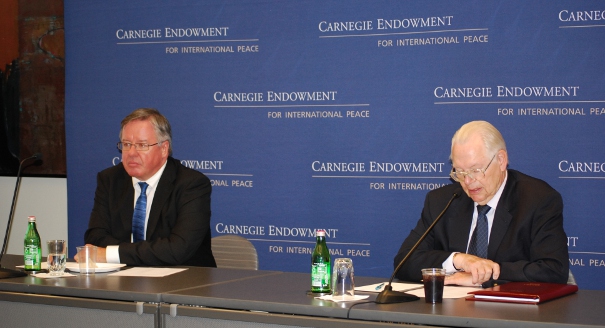Registration
Thank you!
You will receive an email confirming your registration.
IMGXYZ3470IMGZYXThere were high hopes for Ukraine’s speedy transition to a wealthy free market democracy and full membership in the European and Euro-Atlantic communities when it declared independence in 1991. Carnegie’s Pekka Sutela, discussed how Ukraine fell short of these targets and has become the "sick man of Europe." Carnegie’s Ambassador James F. Collins moderated.
Ukraine’s Track Record
- Keeping Up with the Region: Expectations for Ukraine’s economic growth were strengthened by democratization efforts after the Orange Revolution. However, Ukraine was one of the poorest of Soviet republics, Sutela said, and has not improved its standing in comparison to its peers twenty years later. “Ukraine has grown with the region,” explained Sutela, “neither catching up nor lagging behind.”
- Economic Indicators: Ukraine was ranked 163rd out of 183 countries in the 2012 Index of Economic Freedom, the lowest ranked country in Europe, said Sutela. In fact, Ukraine had worse rankings than Kazakhstan and Russia on the World Bank’s 2011 Doing Business rankings on almost all counts, Sutela added.
- Foreign Trade and Payments: Ukraine’s current account deficit grew to $8.75 billion in 2011 from $2.13 billion in 2010, coinciding with a great capital outflow and a decrease in official reserves due to European financial regression, said Sutela. Simultaneously, Ukraine needs to service $8.2 billion of public debt and more than $50 billion of total debt.
- Fiscal Problems: Ukraine faces an exceptionally large pension burden with an aging population, said Sutela. In addition, Ukraine’s official budget deficit reached 4.3 percent of GDP, but it is likely greater due to budget deficits in state banks and companies, he added.
- Gas: Ukraine faces astronomical gas import prices, with $400 per thousand cubic meters in the fourth quarter of 2011, and $416 at the beginning of 2012, according to the contract, Sutela said. It also received less transit revenue due to the Nord Stream pipeline. European buyers are demanding and getting price discounts for natural gas from Russia, which also puts pressure on transit fees. Ukraine claims it will decrease gas imports from 40 billion of cubic meters in 2011 to 27 billion of cubic meters in 2012, but it is unclear how the country plans to do this, said Sutela. Ukraine has potential to replace some of its cuts in natural gas consumption by coal but Ukrainian unconventional gas deposits will only be available for use in about two decades, said Sutela.
Keeping Up With Its Peers
- Problem with Statistics: The true depth of the economic decline of the former Soviet Union countries in the 1990s is unclear, due to high inflation, changes in price relations, and structural changes. In addition, estimating the true size of the shadow economy, which is especially large in Ukraine and cannot be taxed, is difficult, said Sutela. “As such, we do not really know how fast countries have been growing,” he concluded.
- Gross Domestic Product: It is probable that the steep decline in Ukraine’s GDP in the 1990s provides for fast recovery growth, said Sutela.
- Capital Stock and Infrastructure: Due to post-war reconstruction, it is possible that Ukraine inherited better capital stock and infrastructure than many of its peers, which helped in its economic performance. However, according to 2011 Sector Transition Indicators of the European Bank for Reconstruction and Development, Ukraine is not better in infrastructure and general industry reform, said Sutela.
- The Ukrainian Curse: Rampant corruption and easy access to state resources by elites likely contributed to Ukraine’s economic performance, Sutela said. Unit values of Ukrainian exports, such as metals, metallurgy, and petrochemicals, have risen with fast global growth in the 1990s and early 2000s. At the same time, the price of energy needed to produce Ukrainian exports, in particular Russian natural gas, remained low. These conditions allowed domestic elites to create a rent system where they controlled access to state resources, explained Sutela.
- Ukraine in the Gray Zone: Ukraine is aiming at the best of both worlds, said Sutela. Its export markets are in Europe and Asia, yet its import markets are in Russia. The country faces the challenge of trying to maintain national independence and access to cheap raw materials as it straddles the divide between Europe and Russia.
Ukraine’s Badly Functioning Economy
- Influence of the Past: According to modern economics, past institutions and culture can have an impact on the modern economic performance of a country, said Sutela. Ukraine had a tragic twentieth century, where it served as the battlefield for world wars and civil wars, Stalinism, collectivization, the Holocaust, and forced population movements. This history manifests as a collective lack of individualism in Ukraine, Sutela asserted.
- Breaking the Cycle: The vicious circle can only be broken by Ukrainians themselves, said Sutela. There is no lack of reform blueprints available for Ukraine. Its inability to implement dramatic policy changes in social security, pension reforms, and energy sector stem from the lack of political will, concluded Sutela.
